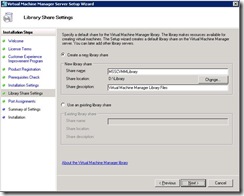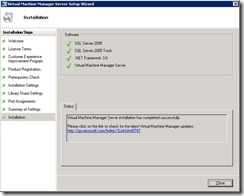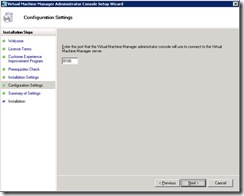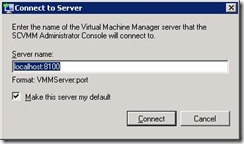Hello. This time we will learn to install the SCVMM 2007. This guide is intended, to show the installation step by step. The SCVMM 2007, allows us to manage virtual machines (VM) in a virtualization environment on Windows Server 2003.
Some features of SCVMM 2007:
- Centralized Management of VMs on Virtual Server Platform 2005 SP2.
- Conversion of VMs to VMware virtualization support on Windows (either Virtual Server 2005 SP2 or Hyper-V on Windows Server 2008). This process also denom V2V.
- Converting physical servers to virtual (P2V).
- Centralized Library (Pictures and virtual disks).
- Smart Display, SCVMM stores and places the virtual server on a host with enough physical resources to function properly.
If you want to know more about the product can access the home page. http://www.microsoft.com/systemcenter/virtualmachinemanager/en/us/default.aspx
Data Table SCVMM 2007: http://go.microsoft.com/fwlink/?LinkId=89128
start with the step by step.
- Installing Virtual Machine Manager Server . Place a physical server with good disk storage and RAM. These resources vary depending on the number of VMs that you wish to mount on the server. The OS should be Windows Server 2003 Std or Ent (I recommend Enterprise as it recognizes more than 4GB of RAM). In my case I did a great iron.

- Start the installation by clicking on the setup.exe.

- will load the wizard and check if a component must be installed. In general you need: PowerShell, you can download http://www.microsoft.com/windowsserver2003/technologies/management/powershell/download.mspx , Windows Remote Management Installation or WRMI, http://support.microsoft. com/kb/936059 ;. NET Framework 2.0, http://www.microsoft.com/downloads/details.aspx?familyid=0856eacb-4362-4b0d-8edd-aab15c5e04f5&displaylang=en

- After the pre-requisites have been met, you must select the installation of the database (SQL Server 2005 or SQL Express failing, BD free).

- Libreríay select Create a new port for connectivity between the server and clients. The port 443 (File Transfers), data will be passed to convert a physical server to virtual.
-


- then charged an overview or summary of all settings in the installation of SCVMM.

- The installation should be completed by the end of copying files, installing SQL Express DB (O creating an instance on a dedicated server). NET Framework 3.0 and the Virtual Machine Manager Service.

- then you must install the management console, Virtual Machine Manager Administrator.

- route is selected where to install and TCP port by default 8100, for administration.

- screen installation have Conclude is:

- started the Virtual Machine System Administrator pointing to localhost and port 8100.

- begin to charge the explanation!

- Finally we have the main window, from which resources are managed and the VMs.

- As a last step you must access the Microsoft Update or from a WSUS to update the application.
If there is any doubt or inconveniences have reported me to support them.
Finally I tell you that there is a version Beta of System Center Virtual Machine Manager 2008, soon to be released. I hope soon to show the product and the features it brings.
I say goodbye to all of you, God bless him. Jorge Cordova













